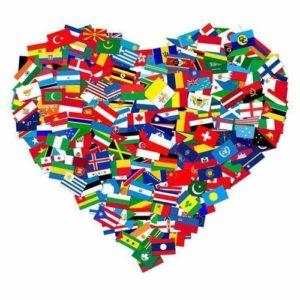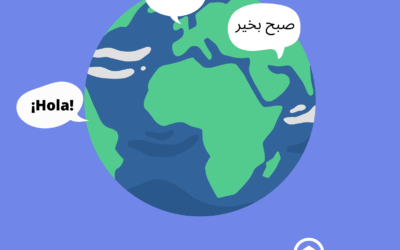Read our Translation Blog
Get the latest fun and facts from the language industry with our blog!
Need advice on website translation and localization?
Browse our ONLINE SHOP for ebooks on how to translate a website!
LingoStar’s Blog 
Welcome to LingoStar’s blog! On this page, you can find a lot of interesting and useful information about the translation industry. Explore topics on website translation and localization and how successful localization can influence your business to help your company grow and go global.
Language Blog Topics
On this blog, you can also learn about professional translators and interpreters, multilingual search engine optimization (SEO), the importance of socializing and networking and translators’ professional ethics. Quite often we write posts about the languages of the world, other cultures, and their traditions. Not only do translators convert texts from a source language to a target language, but they also help people communicate with each other, help establish international contacts, and are often prominent figures in the social, economic, and political life. Lastly, of course, we want you to have fun, so on our blog, you can find many posts that will entertain you and, hopefully, make you smile!
We hope you enjoy our blog and discover a lot of interesting things!
Languages Spoken in the USA: A Melting Pot of Cultures
The USA: A place for everyone | Discover the languages spoken in the USA The USA has always been known for its diversity. Many languages are spoken in the USA. More than three billion people call the United States of America home. Due to its diverse population before British colonization and several waves of immigration, you can find almost every language and cultural background in the US population. The USA has been multilingual since the very beginning. Many languages were spoken in the USA, even before the first settlers set foot on its soil. Tribes, such as the Navajos, Sioux and Keresan spoke over a thousand known languages before first contact with Europeans. Evolution of the English language in the USA When considering why and how a language develops, there are several factors to consider. One of the most important is culture. It is said that the influence of foreign languages spoken in the USA is much more immediate and recent than in any other country. The English language has developed a lot in the USA. For example, some terms have been taken from the languages of the native tribes, such as the word “raccoon”, which was taken from the Powhatan term aroughcun, meaning “animal that scratches with its hands”. You can easily find examples of words being coined from many other languages! Other well-known examples are avocado and canyon from Spanish, and chowder and prairie from French. How many languages are spoken in the USA? With so many cultures co-existing, you may be wondering: How many languages do I need to learn to get around the country? Just... read moreSummer in Italy: An Unforgettable Experience
Unveiling the enchantment of Italy Summer in Italy is a vibrant season of cultural festivals, lively events and warm weather, making it the ideal time to explore and enjoy the country. Italy captivates visitors with its diverse and vibrant offerings. Located in southern Europe, Italy is a boot-shaped peninsula that juts into the Mediterranean Sea. It is renowned for its summer festivals, each reflecting the country’s rich cultural heritage and regional traditions. Immerse yourself in Italian culture: Experience a summer in Italy Italy is known for its rich and varied culture, and getting together is an important part of the country’s traditions. Ferragosto, the day of the Assumption of Mary, is a national cultural festival held on 15th August. This day, everyone celebrates with family reunions, beach trips and fireworks. Many towns and cities hold local festivals and processions. With its diverse landscapes, historic sites, and cultural attractions, Italy offers endless opportunities for summer exploration. Explore ancient ruins such as the Colosseum and the Roman Forum in Rome or visit the Vatican City, marvel at Renaissance art in Florence, or enjoy the modern elegance of Milan. Take in the stunning scenery and views of charming towns like Positano and Amalfi or take a boat tour through Venice. Summers in Italy are enchanting. Also, the summer festivals and other cultural events fuel the country’s music, sports and tourism industries. Summer in Italy: Festivals and cuisine Summer in Italy is synonymous with vibrant festivals. In July and August, the historic Palio di Siena, a thrilling horse race, transforms Siena’s Piazza del Campo into a medieval extravaganza. Venice celebrates the Festa del... read moreThe History of Arabic and Its Relationship with Yemen
The enduring legacy of Arabic Immerse yourself into the rich history of Arabic and its enduring legacy around the globe. It is a journey through the ages of cultural and intellectual growth emanating from the Arabian Peninsula. With its deep history and global influence, it has provided a wealth of culture and communication for centuries. At LingoStar, we recognize the impact of Arabic and strive to bring its beauty and precision to your doorstep through our expert translation services. Origin and evolution The historical Arabic language has many claims to fame spanning from being the original language of poetry to the sacramental language of Islam. First appearing in the 4th century CE it grew and expanded rapidly. Its adoption as the official language of Islam in the 7th Century not only cemented Arabic’s importance but also facilitated its spread throughout the Middle East, North Africa, and parts of Europe, making it a key language for culture, science, and philosophy. Today, more than 400 million people speak Arabic in over 20 countries. Classic and modern Arabic: What’s the history of Arabic? The key aspect of the history of Arabic is its evolution from Classical to Modern Standard Arabic (MSA). While its ancient roots are preserved in academic, literary, and religious texts such as the Quran, the Arabic language has also been thrust into modernity as a necessity for contemporary communication, serving the vast Arabic-speaking world. Today, these two forms serve different purposes and convey many different ideas. Therefore, understanding these differences is crucial for effective translation services, ensuring both historical accuracy and modern relevance. Yemen’s contribution to the history of Arabic... read moreLanguages in India: A Landscape of Linguistic Diversity
Multilingualism of India Let’s talk about India and the languages in India. India is a country largely known for its cultural and linguistic diversity. It boasts over 700 languages. At the same time, it is home to the world’s most linguistically diverse population, showcasing India’s unique tapestry reflecting its rich heritage and history. Therefore, for a business aiming to tap into this diverse market, effective communication is key. As a leading language translation company, LingoStar translators recognize the crucial importance of embracing linguistic diversity in building meaningful connections and fostering growth. The major languages in India Hindi is the official language of India, as declared by the Indian government. It is spoken by nearly 44% of the population and it acts as a lingua franca in many parts of the country. Alongside Hindi, English is one of the languages in India that holds a significant place as an associate official language. Other major languages in India include Bengali, Telugu, Marathi, Tamil, and Urdu, each with millions of speakers and a deep literary tradition. Why do languages matter in India? Effective communication between the languages of India goes beyond mere translation; it also involves the localization of its cultures. Each state often has its own official language, such as Bengali in West Bengal, Tamil in Tamil Nadu, Telugu in Andhra Pradesh, and Marathi in Maharashtra. Therefore, if you do business in India, this means tailoring your message to align with local sensibilities and cultural nuances. As a result, consumers are more likely to engage with content that acknowledges and respects their linguistic and cultural identities. The importance of translating languages... read moreEnvironmental Translation: How Translation Can Contribute to Sustainable Development
Can translators help to improve our environment? The world is facing an environmental crisis. Climate change, biodiversity loss, pollution, deforestation, ecosystem degradation, and natural resource depletion are some of the consequences of human activity. Tackling the global environmental crisis requires individual and collective efforts across different sectors and levels of society to protect future generations. Environmental translation is essential to introduce new regulations and to create campaigns in a globalized world. What is environmental translation? Environmental translation refers to the translation of environmental or scientific documents from one language into another. Some of these documents include policies, regulations, laws, assessments, sustainability reports, agreements, plans, articles and educational materials. There are several purposes for environmental translation or interpretation. This type of language conversion can be used to communicate effectively with diverse audiences and to address environmental issues on a global scale. What to look for in an environmental translator? Professional environmental translators are linguists who specialize in translating documents related to the environment. Environmental translation involves complex concepts, technical terminology, and specific jargon that may not be easily understood by those without expertise in the field. Translators must be familiar with specific areas of environmental science, such as climate change, sustainability, ecology, renewable energy, conservation, waste management, etc. Environmental translators and interpreters must be fluent in both the source and target languages. But, also have an extensive knowledge of environmental vocabulary and concepts. They must be familiar with specialized dictionaries, glossaries and terminology databases to ensure consistency in translations. They must also keep abreast of new developments, trends and terminology in the field. In addition, it is normal for some... read moreConsecutive Interpreting: The Key to a Smooth Communication in Your Meetings
Interpreting services for all your needs Interpreting services are needed in various social situations to facilitate effective communication between different parties who do not share the same language. Some of the most common interpreting modes are consecutive interpreting, simultaneous interpreting, whispered interpreting, also known as chuchotage, and sight translation. In this article, we introduce you to the main mode of interpreting for which we offer interpreting services: consecutive interpreting. What is consecutive interpreting? Unlike simultaneous interpreting, where the interpreter interprets the speaker’s words into the audience’s language within a few seconds, consecutive interpreting takes place after the speaker has finished speaking. While the speaker is speaking, the interpreter takes notes in order to produce an accurate summary of the speech in the other language. Simultaneous interpreting is best suited for meetings where there is one keynote speaker, while consecutive interpreting is more suitable for meetings with several speakers where there will be back-and-forth communication. At LingoStar, we have extensive experience in interpreting projects, especially consecutive interpreting. We regularly work with professional consecutive interpreters on projects in a variety of fields, usually public or social services, including business meetings, legal proceedings, and medical appointments. What to look for in a consecutive interpreter What does it take to become a consecutive interpreter? Can anyone do it, or does it require special training and skills? A professional interpreter needs to practise a number of skills on a regular basis in order to deliver a coherent and structured speech that conveys the same information as the original speech, with the same tone, register, and intonation. Every consecutive interpreter must be proficient in note-taking.... read moreWebsite Globalization: How Investing in Multilingual Websites Can Help You Have a Global Business
The role of translation in a global business How can translation help build a global business? We live in an interconnected society. Globalization integrates economic, political and cultural systems around the world. We consume goods and services from other countries. Through interdependence, most countries rely on each other to meet local demand and sell local products. Translation, like technology, creates interdependence between nations in different parts of the world. Translation plays a critical role in localization because it increases interaction and enables global communication. Translators are essential intermediaries in today’s globalized society, playing a key role in the exchange of ideas and information between countries that speak different languages. Translators can localize your products or services and adapt them to each specific region. If you want to have a global business, you need to implement website localization https://lingo-star.com/what-is-localization/. Why should companies invest in a multilingual website? If you want to expand your business and reach a wider audience, website localization is key. English is the most widely spoken language in the world, but not everyone who consumes your products or services speaks it. When people browse a website, whether they are looking for the latest fashion trends or buying plane tickets for their next trip, they want their user experience to be as enjoyable as possible. Not only does the website for your global business need to be easy to use and intuitively designed, but it also needs to be available in multiple foreign languages to make it accessible to users with different native languages. As a business, having a multilingual website shows respect and understanding for your... read moreProofreading and Editing: The Key for a Successful Translation
Proofreading and editing: the perfect tools for refining a text How do you ensure that a translation is ready to be delivered to a client? Human proofreading and editing services may be the answer. Translators typically spend a considerable amount of time reading, analyzing and translating the original text. Once they have the first version of their translation, it is recommended that they wait a while before reading it again. By doing so, they are more likely to spot errors that they may not have noticed at first. Clients expect perfection from a professional translation agency. Therefore, in addition to translators checking their own work, another professional linguist or native translator should ideally review the translation and provide feedback to ensure it is flawless. This is where the work of proofreaders and editors comes in. What is proofreading? What is editing? Proofreading and editing are two distinct parts of the process of improving a text. Once the translator has completed the translation process, a number of processes must be performed to ensure the translation is accurate and ready to be delivered to the client. Editing a translation is a more in-depth revision of a text. When a text is sent for editing, it usually requires more changes than a text sent for proofreading, so editors take more time than proofreaders to complete their work. An editor evaluates aspects such as the writing style, the register, the structure and the flow of the text. Proofreading, on the other hand, usually takes place after the text has been edited. It is the last step before submitting the document. Proofreading may not... read moreThe Future of Translation: Bridging Tradition and Innovation | 2024
What will the future of translation look like? In the dynamic landscape of technological innovation, the translation industry stands at the crossroads of tradition and transformation. In the midst of rapid technological evolution, the translation industry is grappling with the challenges and opportunities of 2024. As the year unfolds with a wave of cutting-edge advances, questions are being asked about the relevance of traditional translation agencies. But rather than fading into the background, these agencies are proving resilient and adaptable, embracing and expanding their role in the face of new technologies. This blog post explores how translation agencies are not only holding their own but are essential to harnessing the full potential of technological breakthroughs in language translation. What key role will these agencies play in navigating the future of translation? The human touch in AI-powered future of translation While AI-powered translation models have made remarkable progress, they still lack the nuanced understanding and cultural sensitivity that human translators bring to the table. As a result, translation agencies are integrating AI into their workflows to improve efficiency while at the same time recognizing the irreplaceable value of human expertise in preserving the nuances of language and culture. By seamlessly combining the speed of AI with the innate human touch, translation agencies offer a unique and comprehensive approach that ensures accuracy, context and cultural relevance in every translation project. Complex project management and quality assurance determine the future of translation The scope of translation often goes beyond simple language conversion, especially in industries with complex technical terminology or specialized content. As a result, translation agencies play a critical role in... read moreHoliday Season: Dishes From Around the World
Savouring Central European Christmas: a cultural and culinary expedition ‘Tis the season! As the holiday season spirit embraces us, join the Lingo Star team – a diverse group deeply rooted in the traditions of Slovakia, Italy, the Czech Republic and Germany. Unwrap the festive tapestry of these rich cultures. Savour not only the culinary delights but also the universal language of shared customs that bind us together during this joyous season. Slovakia: Eastern European elegance In Slovakia, Christmas is celebrated on December 24th and is marked by unique traditions that add magic to the season. The first meal of the day, Christmas Eve dinner, holds a special place in Slovak traditions. Legend has it that if you refrain from eating all day, you may be rewarded with a glimpse of a golden pig! Christmas traditions and dishes vary from region to region and family to family. Wafers with honey and garlic kick off the feast, followed by a main course of fish, mushroom, or cabbage soup. Some families add prunes to cabbage soup for a unique and delicious twist. Fish, especially carp, with traditional potato salad, is a staple of the Christmas meal. No Slovak Christmas is complete without an array of cookies and cakes adorning homes. Some families go the extra mile and bake 8-10 different types of cookies every year. On Christmas Eve, Baby Jesus, or Ježiško in Slovak, takes centre stage, bringing presents for children under the twinkling tree. To add to the festivities, Slovakia also celebrates St. Nicholas’ Day on December 6th. Children eagerly place their shoes by the door or window in anticipation of... read moreLinguistic Evolution: Challenges and Opportunities for Translators
Dynamic languages: a multifaceted world Language is a living entity in perpetual evolution, constantly evolving and adapting to the ever-changing world around us. This ever-changing nature of language is a fascinating and sometimes challenging aspect for those working in the translation industry. Translators and linguists have to navigate within the intricate web of linguistic evolution, where words and expressions can undergo profound changes. This dynamic nature of language is not only a challenge but it’s also an extraordinary opportunity to engage with diverse linguistic contexts and bridge communication gaps. The translator’s challenge(s): adapting to linguistic evolution Translators and linguists face a unique set of challenges when dealing with the evolving linguistic landscape. They have to keep up with the subtle shifts in meaning, tone, and cultural connotations that words and phrases inevitably undergo over time. However, within this dynamic environment lies a world of exciting opportunities for professional growth. Cultural Proficiency: Embracing Linguistic Evolution with Cultural Insight Because language reflects cultural nuances, staying abreast of linguistic changes requires a deep understanding of the cultures associated with those languages. Translators who embrace this aspect of linguistic dynamism develop a heightened cultural proficiency that enables them to produce more accurate and culturally sensitive translations. Specialization: Thriving in Evolving Fields with Specialized KnowledgeLinguistic evolution often leads to the emergence of new terminology and jargon in various fields, from technology to healthcare. Translators can choose to specialize in these areas, enhancing their industry-specific knowledge and becoming sought-after experts in their niche. Continuous Learning: Staying on the Cutting Edge of Linguistic DevelopmentsAdapting to linguistic change requires ongoing training. Translators and linguists are encouraged to... read moreTranscreation and Creation: The Power Of Words
Transcreation, the perfect cocktail of translation and creation, is a powerful tool. The power of words intentionally strung together to bridge cultural and communication gaps effectively in diverse markets. It is a marketing strategy used to adapt content to different cultural contexts and languages beyond word-for-word translation. What are transcreation and creation? Transcreation is the art of reinventing, recreating, and reimagining content. By focusing on the essence, emotion, and cultural nuances of a message, they preserve the original intent and impact of a product or service. However, successful communications must transcend barriers. It recognises that language and culture cannot be separated, and therefore, adapts to cultural nuances like idioms, humour, and sensitivities. Transcreators ensure that brand messages resonate with the target audience on a deeper and emotional level to form stronger brand connections leading to increased brand engagement. A guide to creative adaptation in marketing The process typically starts with a thorough understanding of the brand, its values, the target audience, the desired message, and the goal. Thus, transcreators will analyze the source content and identify key elements. They will reimagine visuals, alter metaphors, creatively rewrite, and even recreate new concepts adapted to fit the cultural context of the target market. What do transcreation and creation entail? Transcreation involves extensive research, cultural immersion and firm mastery of the power of words. This further ensures that the adapted content aligns with the cultural norms, customs, and preferences of the target audience. By taking into account cultural sensitivities, historical references, local trends, and idiomatic expressions, they can appeal positively and avoid cultural faux pas with the intended market. How to localize... read moreLost In Translation
Balancing Creativity and Cultural Relevance Have you ever been lost in translation? A recurring mistake to make is to assume that translation is limited to mere linguistic conversion, that is swapping a word for another word. The reality, however, is that translators go above and beyond to be able to capture and convey messages accurately in different languages and cultures. Not an easy feat, by any means, as striking the right balance between creativity and cultural relevance is exceptionally challenging. Creativity plays a radical role in translation, especially so when conveying idioms, metaphors, and cultural nuances with no direct equivalents in other languages. These situations call to the creative skills of translators to concoct inventive solutions to preserve the impact and goal of the source text while ensuring the transfer in language maintains clarity and understanding in the target language. A successful translation is a culturally relevant one. Where a deep understanding of cultural norms, customs and values shine through in both the source and target language. The translator needs to ensure that the translated content is appropriate and relatable to the targeted audience. They take into account historical, social, and linguistic nuances that can potentially harm the message intended. Transcreation: Avoid getting lost in translation The perfect blend of translation, creation and cultural relevance is transcreation. Transcreators have the flexibility to deviate from the literal translation, original structure, and limited creativity. They can focus on recreating and restructuring the words around the message, goal and emotion of a product or service. They incorporate humour, wordplay, and other culturally relevant elements, eliminating the possibility of a-lost-in-translation problem. Striking the... read moreTranslation Localization: Translating for Global Markets
Translation localization involves translators adapting a translated text to the requirements of a specific geographical area. They adjust the content to make it sound familiar and easily understood by the target audience. Localization can include elements such as cultural references, illustrative colours and images, local dialects, adaptations of dates, times, or currencies, and units of measurement, as well as local information. For high-quality localization, localization translators must have specialized skills compared to general translators. They need to have an in-depth knowledge of the culture, idiom, and lifestyle of the people from the source and target area. Ideally, native speakers of the target language should carry out the translation, but it is also essential to choose translators with specific knowledge of the target region or dialect. Therefore, companies looking to expand into new markets find localization particularly beneficial. It enables them to reflect the local culture, translate content into the local dialect, personalize their product or service, adapt promotions and events to the national holidays of the target country, and comply with local regulations where necessary. Certain types of translation require more localization than others, depending on their specific nature and the need for cultural, linguistic, and technical adaptation. Here are a few examples of types of translation that often require extensive localization: Website localization Websites often contain region or country-specific content, such as information about local services, promotions, cultural references, and news. Localization is crucial to ensure that the website is tailored to the language, culture, and local preferences of the users. Software and application localization Localization of software and applications involves adapting the user interfaces, menus, error messages,... read moreWhy working with professional translators is worth its weight in gold
Translation is a complex and vital process. It requires a deep understanding of the source and target languages in the cultural context they are being used. Working with professional translators can help businesses and organizations communicate effectively with their target audiences. Every language has its own set of linguistic and cultural nuances that must be considered during the translation process. While it can be tempting to address your translation needs with an acquaintance, a friend or a native speaker of the target language, professional translators spend several years training for their trade for a reason. Of course, being a passionate linguist is a must, but it’s not enough! Here are six of the most important attributes of a professional translator: 1. Working with professional translators fluent in the languages they work in When translating languages, choosing a professional translator who is fluent in both languages is extremely important. The translator should have an in-depth understanding of the cultural and linguistic nuances of both languages. They should also be able to translate the text accurately while staying true to the original meaning. 2. Hiring a professional translator ensures that your target audience comes first One of the first steps in translating from one language to another is research. Thoroughly researching the target audience and their target cultural relevance is crucial. This will help ensure that the translation accurately conveys the intended meaning and message of your text. For example, the terminologies and expressions used in legal documents will be different from those used in marketing campaigns. Similarly, those used in children’s resources will be very different from those used in... read moreTranslation Blog and News
LingoStar has been a language services provider in Canada, the USA, and Europe for more than a decade. We are proud to say that we cooperate with professional translators, interpreters, and other language specialists worldwide and work with over 100 language pairs. If you are looking for a reliable translation company, contact LingoStar! We are always ready to help you with your projects and documentation. Get a free quote online.














